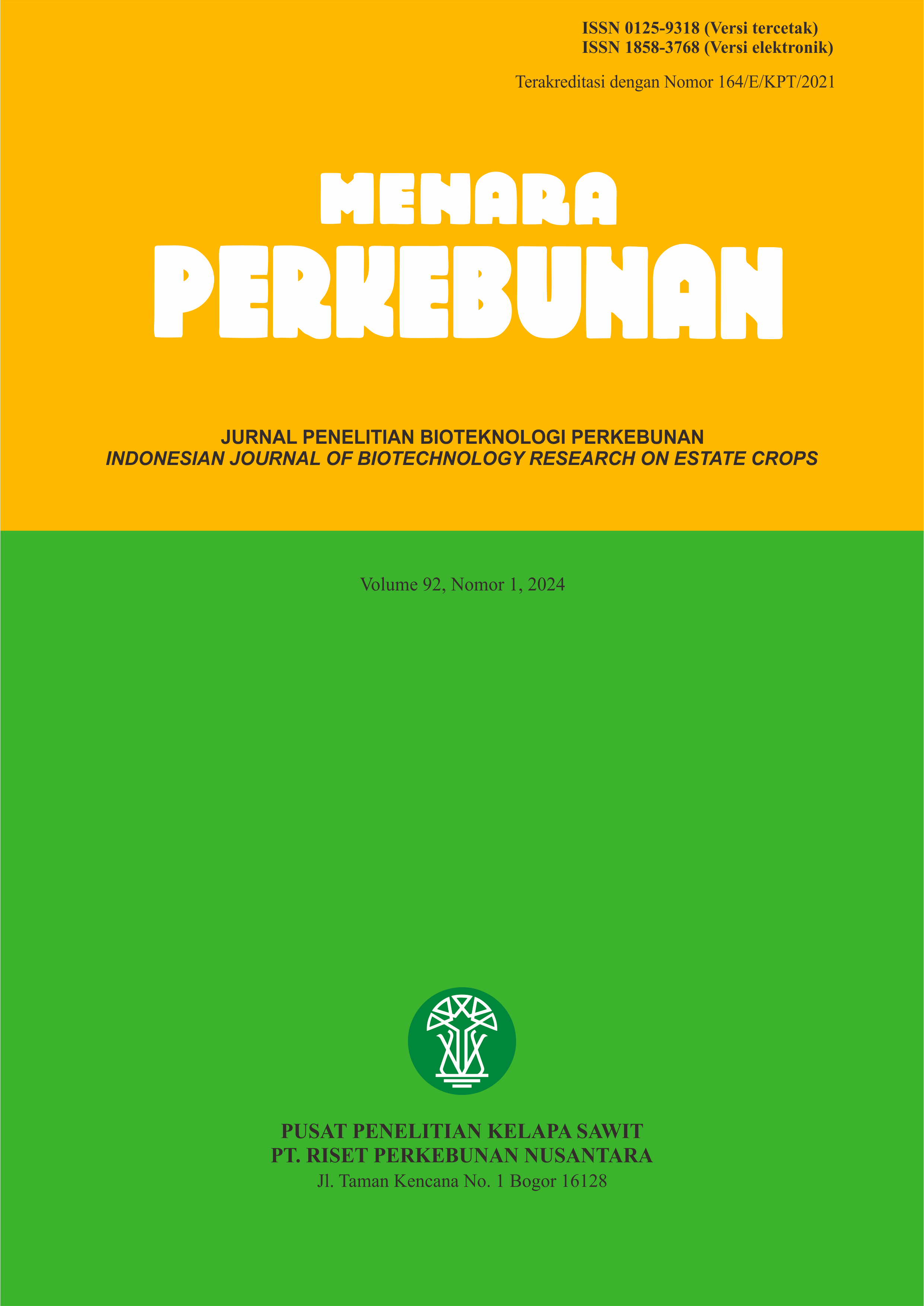Freeze drying technology and its impact on the characteristics of kopyor coconut flesh
DOI:
https://doi.org/10.22302/iribb.jur.mp.v92i1.555Keywords:
blanching, dried kopyor, freeze dryingAbstract
Kopyor coconut is one of Indonesia's origin germplasms that has a high economic value. Theflesh of the kopyor coconuts is quickly damaged characterized by rancidity due to the presence of microorganisms. This study aimed to investigate the effect of blanching and freeze-drying processes, considering the factors of drying duration and pressure, on the quality of kopyor coconut Flesh. The kopyor coconuts used in this studywere obtained from Ciomas Plantation IOPRI Bogor Unit, Bogor, West Java. The kopyor coconut flesh was grouped into two categories: one treated with steam blanching at 100 °C for 10 min and the other without blanching treatment. Freeze-drying processes were carried out for 12, 24, 48, and 72 h and at absolute pressures of 0.01 and 0.05 mbar. The characteristics observed were the moisture content, pH, whiteness index,and free fatty acids content (FFA).The combining of steam blanching and freeze-drying process for 48 h and a pressure of 0.01 mbar was the best treatment. The dried product had uniform texture with moisture content of 5.31%, whiteness index of 89.67%, pH of 7,04 and free fatty acid of 0,51%. These values indicated that the quality of dried fruit complied with the Indonesian standard of dried fruit quality (SNI 3710:2018).
Downloads
References
Angeles, J. G. C., Lado, J. P., Pascual, E. D., Cueto, C. A., Laurena, A. C., & Laude, R. P. (2018). Towards the understanding of important coconut endosperm phenotypes: Is there an epigenetic control. Agronomy, 8(10), 225. https://doi.org/
3390/agronomy8100225
Antigo, J. L. D., Bergamasco, R. C., & Madrona, G. S. (2017). Effect of pH on the stability of red beet extract (Beta vulgaris L.) microcapsule produces by spray drying or freeze drying. Food Science Technology, 38(1), 72-77. http://dx.doi.org/10.15
/1678-457X.34316
Antu, M. Y., Hasbullah, R., & Ahmad, U. (2016). Dosis blansir untuk memperpanjang umur simpan daging buah kelapa kopyor. Jurnal Penelitian Pascapanen Pertanian, 13(2), 92–99. https://doi.org/10.21082/jpasca.v13n2.2016.91-98
AOAC Association of Official Analytical Chemist. (2019). Official methods of analysis of the association of official analytical chemist (No. Ed. 21). AOAC International.
Debusca, A., Tahergorabi, R., Beamer, S. K., Partington, S., & Jaczynski, J. (2013). Interactions of dietary fibre and omega-3-rich oil with protein in surimi gels developed with salt substitute. Food Chemistry, 141, 201-208. https://doi.org/10.1016/j.foodchem.2013.2013.02.111
Ermi, S., Prabawati, S., & Hidayat, T. (2007). Optimasi kecukupan panas pada pasteurisasi santan dan pengaruhnya terhadap mutu santan yang dihasilkan. Jurnal Pascapanen, 6(1): 34-42. https://doi.org/10.21082/jpasca.v6n1.2009.3
-42.
Fadhilatunnur, H., Subarna, Murtadho, Z., & Muhandri, T. (2022). Pengeringan cabai merah (Capsicum annum L.) dengan kombinasi oven microwave dan kipas angin. Jurnal Mutu Pangan, 9(1), 26-35. https://doi.org/10.29221/j
mpi.2022.9.1.26
FAO Food and Agriculture Organization. (2019). Production of Coconuts: top 10 producers. https://www.fao.org/faostat/en/#data/QC/visualize
Hiranvarachat, B., Sakamon, D., & Naphaporn, C. (2011). Effects of acid pretreatments on some physicochemical properties of carrot undergoing hot air drying. Food and Bioproducts Processing, 8(9), 116–127. https://doi.org/10.10 16//j.fbp.2010.03.010
Horuz, E., Bozkurt, H., Karatas, H., & Maskan, M. (2020). Microwave-conventional drying characteristics of red pepper: modelling, temperature profile, diffusivity and activation energy. Journal of Agricultural Science and Technology, 22(2), 425-437.
Kaewsuksaeng, S., Tatmala, N., Srilaong, V., Pongprasert, N. (2015). Postharvest heat treatment delays chlorophyll degradation and maintains quality in Thai lime (Citrus aurantifolia Swingle cv. Paan) fruit. Postharvest Biology and Technology, 100, 1–7. https://doi.org/10.1016/j.postharvbio.2014.09.020
Karyadi, J.N.W., Akbar, M.A., Ayuni, D., & Bintoro, N. (2021). Blanching pretreatment on freeze-drying process to preserve the quality of Parkia speciosa. Jurnal Ilmiah Rekayasa Pertanian dan Biosistem, 9(1), 96-107. https://doi.org/10.2930
/jrpb.v9i1.245
Luis, M. R. O., & Francisco, J. P. (2013). Comparison study of conventional hot-water and microwave blanching on quality of green beans. Journal of Innovative Food Science and Emerging Technologies, 20, 191–197. https://doi.org/10.1016/j.ifset.2013.09.009
Mashud, N., & Manaroinsong, E. (2007). Teknologi kultur embrio untuk pengembangan kelapa kopyor. Buletin Palma, 33, 37–44. https://reposi
tory.pertanian.go.id/handle/123456789/4044
Paramitha, D. A. I., & Juliadi, D. (2018). Pengaruh suhu terhadap bilangan peroksida dan asam lemak bebas pada VCO hasil fermentasi alam. Cakra Kimia (Indonesian E-Journal of Applied Chemistry), 7(2).https://onesearch.id/Record/IO
S169.article-56191/TOC
Peters, K., & Ramirez, C. (2019). Technology of fruits and vegetable processing. Waltham Abbey Essex: ED-Tech Press
Pinar, H., Cetin, N., Ciftic, B., Karaman, K., & Kaplan, M. (2021). Biochemical composition, drying kinetics and chromatic parameters of red pepper as affected by cultivars and drying methods. Journal of Food Composition and Analysis, 102. https://doi.org/10.1016/j/jfca.202
103976
Pusat Penelitian Kelapa Sawit. (2022). Laporan Hasil Uji Laboratorium Pengujian. PPKS Unit Bogor
Rajesh, M. K., Sabana, A. A., Rachana, K. E., Rahman, S., Jerard, B. A., & Karun A. (2015). Genetic relationship and diversity among coconut (Cocos nucifera L.) accessions revealed through SCoT analysis. Biotech, 3(5), 999–1006. https://doi.org/10.1007/s13205-015-0304-7
Rozana, Hasbullah, R., & Muhandri, T. (2016). Respon suhu pada laju pengeringan dan mutu manisan mangga kering (Mangifera indica L.). Jurnal Keteknikan Pertanian, 4(1), 59–66. https://doi.org/10.19028/jtep.04.1.59-66
Samarakone, H. S. M. D., & Yalegama, L. L. W. C. (2014). Quality evaluation of deep frozen scraped coconut. Coconut Research and Development Journal, 30(1), 11-17. https://doi.org/10.37833/cord.v30i1.81
Santoso, U., Kubo, K., Ota, T., Tadokoro, T., & Maekawa, A. (1995). Nutrient composition of kopyor coconuts (Cocos nucifera L.). Journal Food Chemistry, 57(2), 299-304. https://doi.org/10.1016/0308-8146(95)00237-5
Siriwongwilaichat, P., Thongart, K., & Thaisakornphan, P. (2016). The effect of blanching on texture and color of frozen young coconut meat. Journal of Food and Applied Bioscience, 2, 143-151. https://doi.org/10.14456
/fabj.2014.16
Downloads
Submitted
Accepted
Published
How to Cite
Issue
Section
License
Copyright (c) 2024 Faleh Setia Budi, Alyssa Nesiananda, Azis Boing Sitanggang

This work is licensed under a Creative Commons Attribution 4.0 International License.
Authors retain copyright and grant the journal right of first publication with the work simultaneously licensed under a Creative Commons Attribution License that allows others to share the work with an acknowledgement of the work's authorship and initial publication in this journal.













